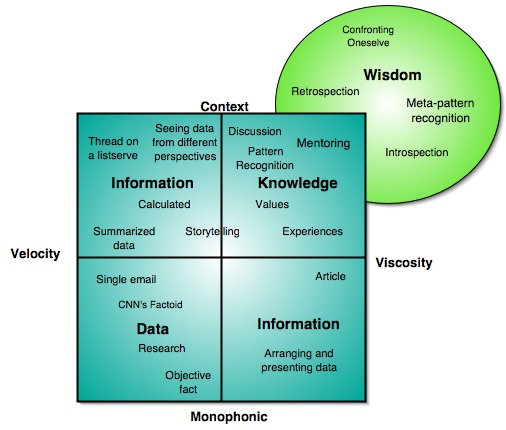Velocity - the speed with which knowledge moves through an organization.Viscosity - the richness or thickness of the knowledge transferred. -- Davenport and Prusak (1998) Mobil Oil's engineers developed some sophisticated ways of determining how much steam is required to drill under certain conditions. When they applied their techniques, they found they could reduce the amount of steam they generated themselves and bought from outside sources. Since they knew the precise amount needed, the potential savings were huge. So they embedded the technique in an intelligent system, with the main focus being the knowledge's velocity in order to quickly get the information out to the field. This was done by sending a memo to all the drilling operations detailing the calculations and benefits. They assumed other sites would quickly adapt the innovation. Nothing happened. The effective viscosity level was zero. Simply improving a process will not be enough to win over everyone. So Mobil came up with some other techniques for transferring the knowledge, such as videos and case studies and soon raised the adoption rate to 30%. That is, they added viscosity to it. It now looks as if it will grow to 50%. Will it ever reach 100%? Who knows? The resistance to abandoning processes that have been successful for years is a universal phenomenon and is not just limited to Mobil. Velocity strips knowledge and information down to its bare essentials by removing portions of its context and richness. And this stripping effect often takes the message down to the next level for its intended receivers -- from knowledge to information or from information to data. Thus the intended knowledge exchange fails. Now look at how 3M does it -- they have regular meetings and fairs for exchanging knowledge. One of their most famous products, scotch tape, was invented by Dick Drew...a sandpaper salesman. In almost any other company his idea would have been tossed out as tape and research were not his specialty, yet the culture of 3M allows for the viscosity of information to spread. And the way they ensure it spreads is through meetings and knowledge fairs -- it is not left for a chance happening on their intranet or through a memo.

Knowledge requires rich sources and context. For example, one of the best knowledge-enablers for a beginning learner is apprenticeship as it allows a rich exchange of concepts and ideas between the learner and teacher. As one starts to slowly move away from this form of learning, the knowledge exchange slowly starts to decrease, while the rate of information flow increases. That is, in a class, the information is going out to a number of learners at once, hence the speed of information exchange increases; however, the flip-side is that one-on-one interactions decrease, thus the rate of knowledge transfer decreases. This is the first dimension of the data/information/knowledge continuum -- Viscosity/Velocity. The second dimension of the data/information/knowledge continuum is the number of paths or streams of information flow. A single email (monophonic) sent to a direct report is one stream, where as a list server, such as trdev, normally has multiple posts (context) to each thread. The more posts, then the more viewpoints one can gather or harvest. Once a learner moves past the beginner stage, then these multiple viewpoints start to become invaluable as they add context to the knowledge base that one has gained. For example, A PhD student studies one small section of his or her field, but does so from multiple contexts.
ReferenceDavenport T., Prusak L. (1998). Working Knowledge. Harvard Business School Press: Boston, MA. |